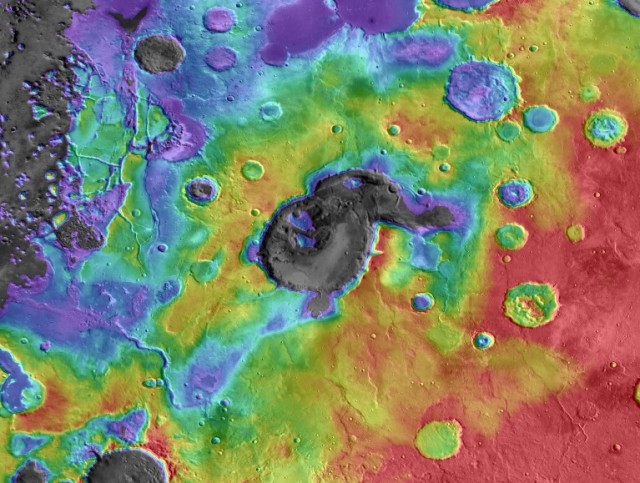Massive, Yellowstone-style eruptions once graced the red planet's surface.
by Scott K. Johnson
Elevation around Eden patera (red is highest, purple/gray is lowest).
NASA/JPL/GSFC/Arizona State University
Martian volcanoes are not known for being hard to spot. The behemoth Olympus Mons, for example, claims the mantle of the largest known volcano in the Solar System. A new paper published in Nature, however, suggests that some volcanoes on the red planet have remained incognito by blending in with the impact craters that dot Mars’ surface. The reason for this mistaken identity is that these volcanoes undergo explosive, Yellowstone-style eruptions, leaving a crater-like caldera behind.
Olympus Mons and its kin are shield volcanoes—broad domes built up by lava flows issuing from a central vent. Volcanism has taken a number of other forms throughout the planet’s history, though, before activity dropped off as Mars cooled. Erosion and burial beneath younger lava flows have made it harder to identify some volcanic features—especially the older ones.
One thing that isn’t hard to find is an impact crater. These scars left by collisions with other bodies are numerous and have a set of distinctive features—there's more to a crater than a hole in the ground. You can usually find a raised area like a bulls-eye in the center of the circular depressions. The rim around the edge is raised above its surroundings. The material that was rudely excavated by the impact is launched radially outward, forming what’s known as an “ejecta blanket” where it settles to the ground.
In a pock-marked region named Arabia Terra, researchers Joseph Michalski and Jacob Bleacher have spotted a few depressions that they think are not like the others. They lack those characteristic features of impact craters, including the neatly circular shape. Instead, they look strikingly like volcanic calderas created by massive eruptions.
Calderas form when the contents of large magma chambers are explosively vomited into the air. With nothing left in the chamber to support the overlying rock, the surface collapses in. If you expected all volcanoes to be impressive, Olympus Mons style peaks, you would miss Yellowstone Caldera, the source of an eruption that dumped ash over the majority of the United States just 640,000 years ago. Michalski and Bleacher think they’ve been looking at calderas on Mars associated with eruptions at least that large.
Their best example is a feature called the Eden patera (pictured above). The nearly 2-kilometer-deep depression lies at the center of a shallow bowl in the surface. Careful inspection reveals signs of the type of faults that form as calderas collapse in on themselves. The convoluted shape of the depression, difficult to explain as an impact, could be the result of several overlapping calderas from separate eruptions. In one portion, the researchers even noticed terraces that resemble the “bathtub rings” left by drained lava lakes.
If these really are calderas, it could add a lot to our knowledge of Mars’ volcanic history. For one thing, they could be the source of some ancient layered rocks on Mars that researchers have puzzled over for some time.
It would also point to a different style of volcanism in Mars’ youth, when its crust was much thinner. If they were widespread, these massive eruptions could have wreaked a lot of havoc on the climate system. Since we want to know how Mars lost its water, its climate history is something we’re keenly interested in learning more about.




0 comments:
Post a Comment